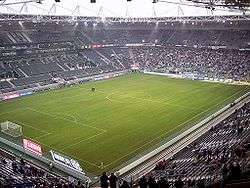Mönchengladbach
Mönchengladbach is a city in North Rhine-Westphalia, Germany with 262,000 inhabitants (2017).
Understand
"MG", as it is often abbreviated, is mostly renown for its Soccer Club, Borussia Mönchengladbach. Though inhabited by more than a quarter million people it appears to be a small town due to infrastructure, culture and "spirit". There is very limited public transit (esp. at night), very few clubs and pubs, no arthouse cinemas, and no "scenes". The metropolises of Cologne and Düsseldorf tend to cause a certain "brain drain" from MG so it appears to some as a kind of suburb to those - though again poorly connected in terms of public traffic.
Get in
By plane
The closest airport is Düsseldorf (DUS IATA) with a number of national and international connections
- 🌍 Mönchengladbach Airport (MGL IATA). a small general aviation airfield
By train
Mönchengladbach can be reached by regional trains. For long distance trains, change in Duisburg, Düsseldorf or Cologne
Mönchengladbach has two stations named "Hauptbahnhof" ("main station") due to the merger of Rheydt and Mönchengladbach and the former main station of Rheydt never being renamed.
By bus
Intercity buses in Germany serve the town.
Get around
Both Rheydt and Mönchengladbach used to have streetcar systems which were shut down in the 1950s and 1960s and there are no concrete plans of ever building one again, making modern Mönchengladbach one of Germany's biggest cities without urban rail of any kind. Mönchengladbach has a bus system but it's limited. From 20:00, it's of no practical help and from 23:00 there are no buses. Buses start from 05:00 (09:00 on Sundays!). On Fridays and Saturdays there is a Night Bus from the party area Alter Markt / Waldhausener Str. to the outskirts, but only until 03:00. You'll always find a taxi of course but they can be costly. Biking is advisable only from April to October, watch out for sudden weather changes. Distances within the centre are easily walked, but Rheydt and the outskirts are not.
See

- 🌍 Schloss Rheydt, Schlossstraße 508. Museum
- 🌍 Schloss Wickrath. restaurant
- 🌍 Abteiberg Museum (Museum of contemporary arts), Abteistraße 27. Tu-Su 11:00 - 18:00. Adults €6, students €3.
Do
- Borussia Mönchengladbach - The club is in the Bundesliga. The stadium capacity is 54.000 people, you might like to join a match, especially versus Bayern München, 1.FC. Köln, or Borussia Dortmund
- On Wednesday nights usually you will start at the Mezcalito at about 21:00, pay an entry fee of €3 and drink half-price drinks. Comfortably numb you will then stagger to the Rossi and finish your work. Sometimes there are open jam sessions or live concerts at the Projekt 42.
- On Thursday there are occasional "poetry slams" at the Projekt 42 (German), better check the HP before.
Buy
Mönchengladbach is not about big shopping tours and never will be, try Düsseldorf, Cologne, Venlo (NL) or Roermond (NL) instead.
If you like German bread: Cafe Ö, Marktstieg 8, very close to the "Alter Markt", is a non-chain-bakery and cafe. They do handcrafted, organic, whole wheat bread. That's what Germans miss when they're abroad (some even more than beer).
If you consider tea bags a crime and are in need of the real stuff: Tee Gschwender, Hindenburgstr., at the "Theater Galerie" will give you sweet relief.
You'll find a Chucks and Vans shop at the Theater Galerie, too.
If you're into punk, hardcore, and ska music and clothes, pay a visit to Nightmare Records, Waldhausener Str. (Altstadt).
Eat
- Das Cafe, Wallstr. 19 (between Hindenburgstr. and Viersener Str.). Daily 10:00 - 01:00. Old fashioned students' cafe food starts at €3.10 (try their baguette), hot drinks €1.90.
- Mokka (Cafe and restaurant, crowded at lunchtime), Stephanstr. 1 (Between Hindenburgstr. and Bismarckplatz).
- El Paso, am Alten Markt.
- 4 komma 3, Rheydter Straße.
- Cafe Trotzdem (near Hochschule).
- Graefen+König, am Alten Markt.
Drink
- Die Nacht (House Club), Waldhausener Str. 25 (Altstadt), ☎ +49 2161 178855. F Sa 23:00 - 05:00.
- Graefen clubbing (Sports Bar and Disney style rock cafe), Alter Markt 23. A little overstyled, Fashionable beer, big TV screen.
Sleep
- 🌍 Hotel André, Geneickenerstraße 104, ☎ +49 2166 254199.
- Hotel Kunst und Nippes, Waldhausener Str. 28 (Altstadt). Single €54, double €82, breakfast included.
- 🌍 Dorint Parkhotel Mönchengladbach, Hohenzollernstrasse 5, 41061 Mönchengladbach, ☎ +49 2161 8930, e-mail: info.moenchengladbach@dorint.com. The hotel offers 145 rooms & 13 suites. From €89 per room/night.
Connect
Nearby
- Schloss Dyck (11 km southeast of Mönchengladbach). Former water castle, transformed into a Baroque chateau during 1656 to 1667. One of the most beautiful and imposing residences in the Rhineland. It is surrounded by an English-style landscape garden with remarkable old and rare trees.
Go next